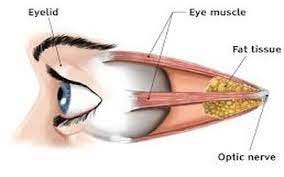Exploring Treatment Options for Thyroid Eye Disease

Thyroid Eye Disease (TED), also known as Graves’ Ophthalmopathy, is a condition that affects the eyes and is often associated with an overactive thyroid (hyperthyroidism). This autoimmune disorder results in inflammation and swelling of the tissues surrounding the eyes, causing a range of symptoms such as eye bulging, double vision, and discomfort. Managing TED involves a multidisciplinary approach, and various treatment options aim to alleviate symptoms and improve overall quality of life.
· Understanding the Thyroid-Eye Connection
o Monoclonal Antibody Teprotumumab (Tepezza)
o Surgery
Steroids and Anti-Inflammatory Medications: One of the primary approaches to treating TED involves the use of steroids, either orally or intravenously, to reduce inflammation. Steroids help alleviate swelling and may improve symptoms like double vision and eye discomfort. In some cases, orbital radiotherapy may be considered alongside steroids to enhance their effectiveness. However, the long-term use of steroids may come with side effects, so careful monitoring is essential.
Surgery for TED:
Surgical interventions may be recommended for patients with severe symptoms or those who do not respond adequately to medical treatments. Orbital decompression surgery is a common procedure that involves removing some of the bone around the eyes to create more space, reducing pressure and relieving symptoms. Eyelid surgery (blepharoplasty) may be considered to correct eyelid retraction or other cosmetic issues associated with TED.

Thyroid Management:
As TED is often linked to hyperthyroidism, managing the underlying thyroid condition is crucial for effective TED treatment. Anti-thyroid medications, radioactive iodine therapy, or thyroidectomy (surgical removal of the thyroid gland) may be recommended to control thyroid hormone levels. Achieving thyroid stability can help prevent the progression of TED and improve overall outcomes.
Biological Therapies:
In recent years, biological therapies have emerged as promising options for treating TED. These medications target specific pathways involved in the autoimmune response, aiming to reduce inflammation and modulate the immune system. Teprotumumab, an FDA-approved biologic, has shown efficacy in reducing eye bulging and improving symptoms in TED patients.
Supportive Therapies:
Supportive measures play a crucial role in managing TED. Lubricating eye drops and ointments can help relieve dryness and discomfort associated with the condition. Prism glasses may be prescribed to address double vision, and lifestyle modifications such as quitting smoking can contribute to overall health and TED management.

Monitoring and Follow-up:
TED requires ongoing monitoring to assess the progression of symptoms and adjust treatment plans accordingly. Regular follow-up appointments with an endocrinologist, ophthalmologist, and other relevant specialists are essential to ensure a comprehensive and coordinated approach to care.
Patient Education and Emotional Support:
Educating patients about TED and its management is crucial for their active involvement in the treatment process. Additionally, emotional support and counseling can help individuals cope with the impact of TED on their daily lives, addressing psychological aspects of the disease.
Conclusion:
Thyroid Eye Disease is a complex condition that demands a tailored and holistic approach to treatment. From traditional interventions like steroids and surgery to newer biological therapies, the array of treatment options reflects the evolving understanding of the disease and the need for personalized care. Balancing the management of hyperthyroidism with targeted interventions for TED symptoms, along with supportive measures and regular monitoring, ensures a comprehensive strategy for improving patients’ quality of life. As research continues to uncover new insights, the future holds the promise of even more effective and targeted therapies for individuals grappling with this challenging autoimmune disorder.
Tagged:
graves disease ,
hashimotos disease ,
disease graves disease ,
hyperthyroidism disease ,
symptoms of a low thyroid ,
thyroid eye disorder ,
thyroid disease ,
symptoms of hypothyroidism ,
eyes with thyroid disease ,
Treatment Options for Thyroid Eye Disease
Related Articles:
Christmas Jewelry Ideas: Designs, Inspiration, and Practical Tips for DIY Jewelry Makers
Considerations Prior to Choosing a Phone Plan
Immigration Lawyer Facts And When To Hire One
How to Teach Effective Math Classes
Investing in Gold Bars: Benefits and Risks
Safeguarding Treasures: A Guide to High-Value Asset Protection
What is Business Process Management Used For?
How to Develop a Successful Telemedicine Application?
Contact us: latestbulletins@gmail.com








